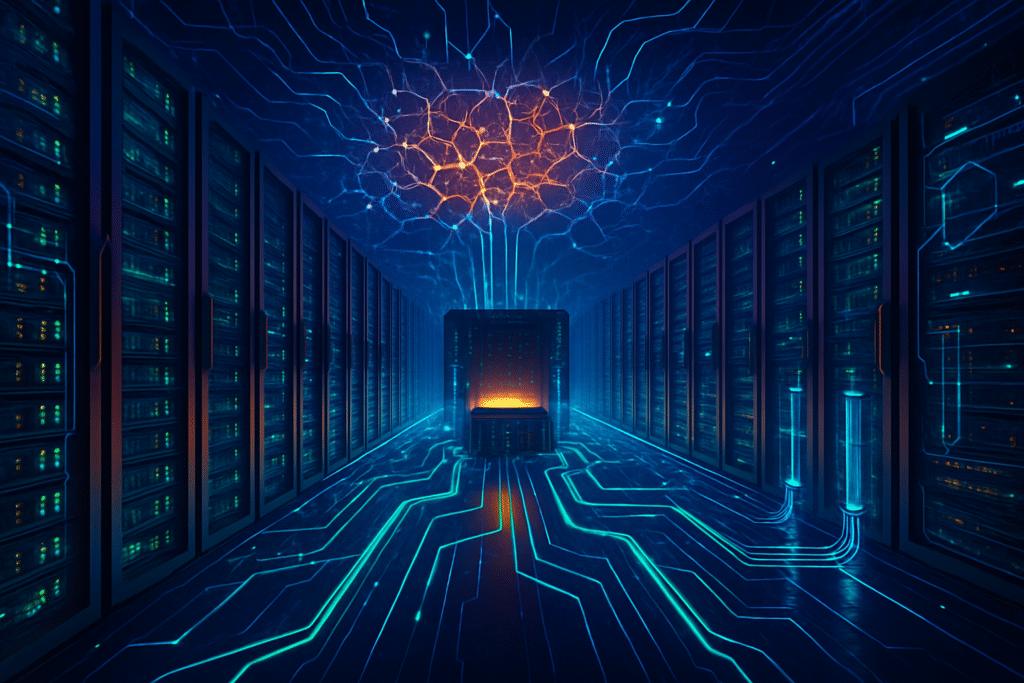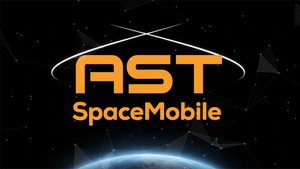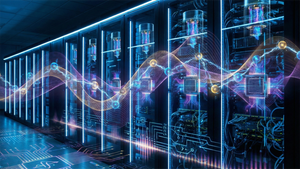
October 20, 2025 – The foundational pillars of the artificial intelligence revolution are undergoing an unprecedented expansion, as the insatiable demand for computational power drives massive investment and strategic shifts across the tech landscape. Today, the spotlight falls on a fascinating confluence of developments: Bitcoin mining giant CleanSpark (NASDAQ: CLSK) formally announced its pivot into AI computing infrastructure, Google Cloud (NASDAQ: GOOGL) continues to aggressively scale its NVIDIA (NASDAQ: NVDA) GPU portfolio, and Insight Enterprises (NASDAQ: NSIT) rolls out advanced solutions to integrate AI infrastructure for businesses. These movements underscore a critical phase in AI's evolution, where access to robust, high-performance computing resources is becoming the ultimate differentiator, shaping the future of AI development and deployment.
This surge in infrastructure build-out is not merely about more servers; it represents a fundamental re-engineering of data centers to handle the unique demands of generative AI and large language models (LLMs). From specialized cooling systems to unprecedented power requirements, the infrastructure underlying AI is rapidly transforming, attracting new players and intensifying competition among established tech titans. The strategic decisions made today by companies like CleanSpark, Google Cloud, and Insight Enterprises will dictate the pace of AI innovation and its accessibility for years to come.
The Technical Crucible: From Crypto Mining to AI Supercomputing
The technical advancements driving this infrastructure boom are multifaceted and deeply specialized. Bitcoin miner CleanSpark (NASDAQ: CLSK), for instance, is making a bold and strategic leap into AI data centers and high-performance computing (HPC). Leveraging its existing "infrastructure-first" model, which includes substantial land and power assets, CleanSpark is repurposing its energy-intensive Bitcoin mining sites for AI workloads. While this transition requires significant overhauls—potentially replacing 90% or more of existing infrastructure—the ability to utilize established power grids and real estate drastically cuts deployment timelines compared to building entirely new HPC facilities. The company, which announced its intent in September 2025 and secured a $100 million Bitcoin-backed credit facility on September 22, 2025, to fund expansion, officially entered the AI computing infrastructure market today, October 20, 2025. This move allows CleanSpark to diversify revenue streams beyond the volatile cryptocurrency market, tapping into the higher valuation premiums for data center power capacity in the AI sector and indicating an intention to utilize advanced NVIDIA (NASDAQ: NVDA) GPUs.
Concurrently, cloud hyperscalers are in an intense "AI accelerator arms race," with Google Cloud (NASDAQ: GOOGL) at the forefront of expanding its NVIDIA (NASDAQ: NVDA) GPU offerings. Google Cloud's strategy involves rapidly integrating NVIDIA's latest architectures into its Accelerator-Optimized (A) and General-Purpose (G) Virtual Machine (VM) families, as well as its managed AI services. Following the general availability of NVIDIA A100 Tensor Core GPUs in its A2 VM family in March 2021 and the H100 Tensor Core GPUs in its A3 VM instances in September 2023, Google Cloud was also the first to offer NVIDIA L4 Tensor Core GPUs in March 2023, with serverless support added to Cloud Run in August 2024. Most significantly, Google Cloud is slated to be among the first cloud providers to offer instances powered by NVIDIA's groundbreaking Grace Blackwell AI computing platform (GB200, HGX B200) in early 2025, with A4 virtual machines featuring eight Blackwell GPUs reportedly becoming generally available in February 2025. These instances promise unprecedented performance for trillion-parameter LLMs, forming the backbone of Google Cloud's AI Hypercomputer architecture. This continuous adoption of cutting-edge GPUs, alongside its proprietary Tensor Processing Units (TPUs), differentiates Google Cloud by offering a comprehensive, high-performance computing environment that integrates deeply with its AI ecosystem, including Google Kubernetes Engine (GKE) and Vertex AI.
Meanwhile, Insight Enterprises (NASDAQ: NSIT) is carving out its niche as a critical solutions integrator, rolling out advanced AI infrastructure solutions designed to help enterprises navigate the complexities of AI adoption. Their offerings include "Insight Lens for GenAI," launched in June 2023, which provides expertise in scalable infrastructure and data platforms; "AI Infrastructure as a Service (AI-IaaS)," introduced in September 2024, offering a flexible, OpEx-based consumption model for AI deployments across hybrid and on-premises environments; and "RADIUS AI," launched in April 2025, focused on accelerating ROI from AI initiatives with 90-day deployment cycles. These solutions are built on strategic partnerships with technology leaders like Microsoft (NASDAQ: MSFT), NVIDIA (NASDAQ: NVDA), Dell (NYSE: DELL), NetApp (NASDAQ: NTAP), and Cisco (NASDAQ: CSCO). Insight's focus on hybrid and on-premises AI models addresses a critical market need, as 82% of IT decision-makers prefer these environments. The company's new Solutions Integration Center in Fort Worth, Texas, opened in November 2024, further showcases its commitment to advanced infrastructure, incorporating AI and process automation for efficient IT hardware fulfillment.
Shifting Tides: Competitive Implications for the AI Ecosystem
The rapid expansion of AI infrastructure is fundamentally reshaping the competitive landscape for AI companies, tech giants, and startups alike. Companies like CleanSpark (NASDAQ: CLSK) venturing into AI compute stand to gain significant new revenue streams, diversifying their business models away from the cyclical nature of cryptocurrency mining. Their existing power infrastructure provides a unique advantage, potentially offering more cost-effective and rapidly deployable AI data centers compared to greenfield projects. This pivot positions them as crucial enablers for AI development, particularly for smaller firms or those seeking alternatives to hyperscale cloud providers.
For tech giants, the intensified "AI accelerator arms race" among hyperscale cloud providers—Amazon Web Services (AWS) (NASDAQ: AMZN), Microsoft Azure (NASDAQ: MSFT), and Google Cloud (NASDAQ: GOOGL)—is a defining characteristic of this era. Google Cloud's aggressive integration of NVIDIA's (NASDAQ: NVDA) latest GPUs, from A100s to H100s and the upcoming Blackwell platform, ensures its competitive edge in offering cutting-edge compute power. This benefits its own AI research (e.g., Gemini) and attracts external AI labs and enterprises. The availability of diverse, high-performance GPU options, coupled with Google's proprietary TPUs, creates a powerful draw for developers requiring specialized hardware for various AI workloads. The competition among these cloud providers drives innovation in hardware, networking, and cooling, ultimately benefiting AI developers with more choices and potentially better pricing.
Insight Enterprises (NASDAQ: NSIT) plays a vital role in democratizing access to advanced AI infrastructure for enterprises that may lack the internal expertise or resources to build it themselves. By offering AI-IaaS, comprehensive consulting, and integration services, Insight empowers a broader range of businesses to adopt AI. This reduces friction for companies looking to move beyond proof-of-concept AI projects to full-scale deployment, particularly in hybrid or on-premises environments where data governance and security are paramount. Their partnerships with major hardware and software vendors ensure that clients receive robust, integrated solutions, potentially disrupting traditional IT service models by offering specialized AI-centric integration. This strategic positioning allows Insight to capture significant market share in the burgeoning AI implementation sector, as evidenced by its acquisition of Inspire11 in October 2025 to expand its AI capabilities.
The Wider Significance: Powering the Next AI Revolution
These infrastructure developments fit squarely into the broader AI landscape as a critical response to the escalating demands of modern AI. The sheer scale and complexity of generative AI models necessitate computational power that far outstrips previous generations. This expansion is not just about faster processing; it's about enabling entirely new paradigms of AI, such as trillion-parameter models that require unprecedented memory, bandwidth, and energy efficiency. The shift towards higher power densities (from 15 kW to 60-120 kW per rack) and the increasing adoption of liquid cooling highlight the fundamental engineering challenges being overcome to support these advanced workloads.
The impacts are profound: accelerating AI research and development, enabling the creation of more sophisticated and capable AI models, and broadening the applicability of AI across industries. However, this growth also brings significant concerns, primarily around energy consumption. Global power demand from data centers is projected to rise dramatically, with Deloitte estimating a thirtyfold increase in US AI data center power by 2035. This necessitates a strong focus on renewable energy sources, efficient cooling technologies, and potentially new power generation solutions like small modular reactors (SMRs). The concentration of advanced compute power also raises questions about accessibility and potential centralization of AI development.
Comparing this to previous AI milestones, the current infrastructure build-out is reminiscent of the early days of cloud computing, where scalable, on-demand compute transformed the software industry. However, the current AI infrastructure boom is far more specialized and demanding, driven by the unique requirements of GPU-accelerated parallel processing. It signals a maturation of the AI industry where the physical infrastructure is now as critical as the algorithms themselves, distinguishing this era from earlier breakthroughs that were primarily algorithmic or data-driven.
Future Horizons: The Road Ahead for AI Infrastructure
Looking ahead, the trajectory for AI infrastructure points towards continued rapid expansion and specialization. Near-term developments will likely see the widespread adoption of NVIDIA's (NASDAQ: NVDA) Blackwell platform, further pushing the boundaries of what's possible in LLM training and real-time inference. Expect to see more Bitcoin miners, like CleanSpark (NASDAQ: CLSK), diversifying into AI compute, leveraging their existing energy assets. Cloud providers will continue to innovate with custom AI chips (like Google's (NASDAQ: GOOGL) TPUs) and advanced networking solutions to minimize latency and maximize throughput for multi-GPU systems.
Potential applications on the horizon are vast, ranging from hyper-personalized generative AI experiences to fully autonomous systems in robotics and transportation, all powered by this expanding compute backbone. Faster training times will enable more frequent model updates and rapid iteration, accelerating the pace of AI innovation across all sectors. The integration of AI into edge devices will also drive demand for distributed inference capabilities, creating a need for more localized, power-efficient AI infrastructure.
However, significant challenges remain. The sheer energy demands require sustainable power solutions and grid infrastructure upgrades. Supply chain issues for advanced GPUs and cooling technologies could pose bottlenecks. Furthermore, the increasing cost of high-end AI compute could exacerbate the "compute divide," potentially limiting access for smaller startups or academic researchers. Experts predict a future where AI compute becomes a utility, but one that is highly optimized, geographically distributed, and inextricably linked to renewable energy sources. The focus will shift not just to raw power, but to efficiency, sustainability, and intelligent orchestration of workloads across diverse hardware.
A New Foundation for Intelligence: The Long-Term Impact
The current expansion of AI data centers and infrastructure, spearheaded by diverse players like CleanSpark (NASDAQ: CLSK), Google Cloud (NASDAQ: GOOGL), and Insight Enterprises (NASDAQ: NSIT), represents a pivotal moment in AI history. It underscores that the future of artificial intelligence is not solely about algorithms or data; it is fundamentally about the physical and digital infrastructure that enables these intelligent systems to learn, operate, and scale. The strategic pivots of companies, the relentless innovation of cloud providers, and the focused integration efforts of solution providers are collectively laying the groundwork for the next generation of AI capabilities.
The significance of these developments cannot be overstated. They are accelerating the pace of AI innovation, making increasingly complex models feasible, and broadening the accessibility of AI to a wider range of enterprises. While challenges related to energy consumption and cost persist, the industry's proactive response, including the adoption of advanced cooling and a push towards sustainable power, indicates a commitment to responsible growth.
In the coming weeks and months, watch for further announcements from cloud providers regarding their Blackwell-powered instances, additional Bitcoin miners pivoting to AI, and new enterprise solutions from integrators like Insight Enterprises (NASDAQ: NSIT). The "AI compute gold rush" is far from over; it is intensifying, promising to transform not just the tech industry, but the very fabric of our digitally driven world.
This content is intended for informational purposes only and represents analysis of current AI developments.
TokenRing AI delivers enterprise-grade solutions for multi-agent AI workflow orchestration, AI-powered development tools, and seamless remote collaboration platforms.
For more information, visit https://www.tokenring.ai/.





